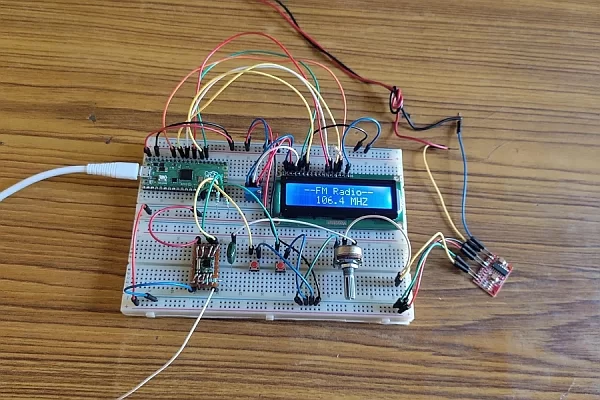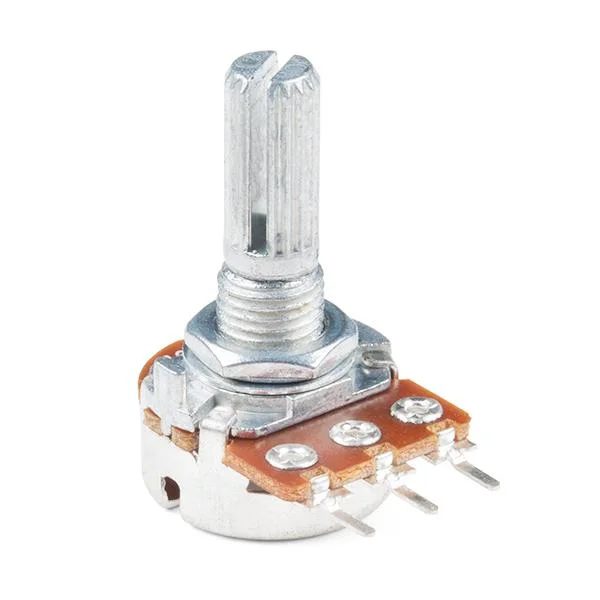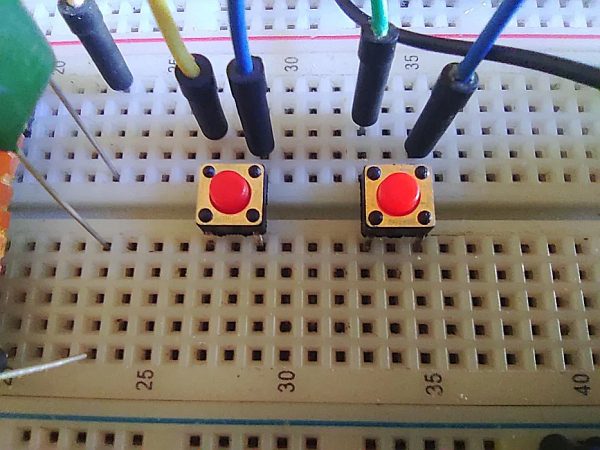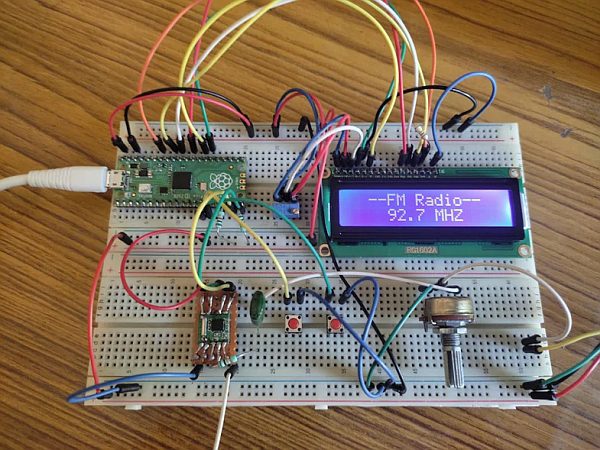In this Instructables we are going to make a FM radio receiver using raspberry pi pico and TEA5767 FM receiver chip. Here I am using micropython programming language to program the Raspberry pi pico. let’s get started!
Supplies
List of hardware:
- Raspberry pi pico
- TEA5767 FM receiver chip
- HD44780 LCD (16*2, blue back color)
- Pushbutton
- PAM8403 Class-D Stereo power amplifier module
- Bread board–2
- Jumper wires
- Resistors (1K—2, 10K—1, 100–1)
- Capacitors (0.1UF)
- Potentiometer (10K)
- Multiturn potentiometer(10K)
- Speaker (4-ohm, 3W)
- Micro-B USB cable
Step 1: Connecting LCD to Pico Board
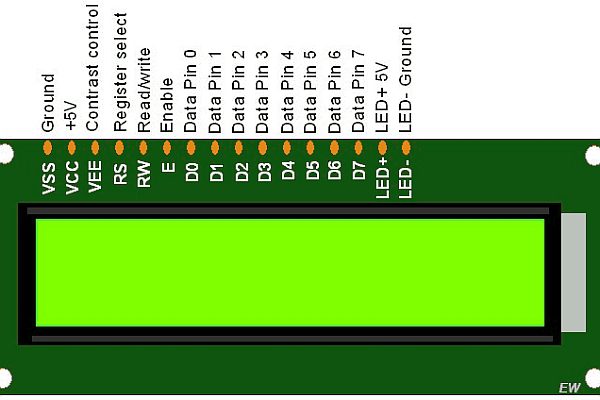
Join both the bread board to each other. Insert the Raspberry pi pico board and LCD in the upper bread board as shown in the diagram. Connect the Pins of the LCD to Raspberry pi pico according to given wiring scheme:
RS ——> GPIO-21
E ——-> GPIO-22
D4 ——> GPIO-23
D5 ——> GPIO-26
D6 —–> GPIO-27
D7 ——> GPIO-28
A ——-> To the positive supply rail of the upper bread board in series with a 100-ohm current limiting resistor to limit the current of backlight LED of the LCD
K ——-> To the negative supply rail of the upper bread board
Vss —–> To the negative supply rail of the upper bread board
Vdd —-> To the positive supply rail of the upper bread board
Vo —–> TO the viper pin of the 10K potentiometer
R/W —-> To the negative supply rail of the bread board
D0 ——-> Not used
D1 ——> Not used
D2 —-> Not used
D3 —–> Not used
Connect the remaining pins of the 10K Potentiometer to the negative and positive supply rail of upper bread board respectively. This 10K potentiometer is used to adjust the contrast of the characters of the display.
Step 2: Connecting TEA5767 to Pico Board
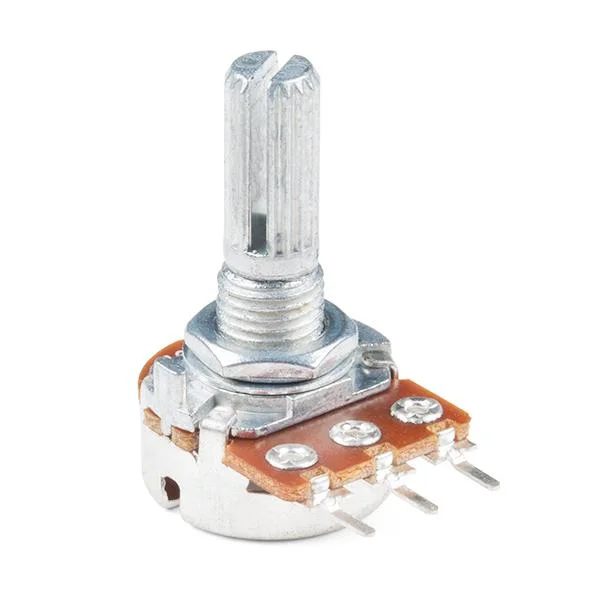
Insert the TEA5767 breakout board to the lower breadboard as shown in the picture. Connect the pins of TEA5767 breakout board according to the given wiring scheme:
SDA —–> GPIO-14
SCL ——> GPIO-15
Vcc ——> To the positive supply rail of the upper bread board
GND ——> To the negative supply rail of lower bread board
L-OUT —-> T0 the 0.1UF capacitor in series with a 10K Resistor
Antenna —–> TO a long jumper wire
Also connect the SDA and SCL pins of the TEA5767 To the Positive supply rail of the bread board through two 1K resistor. These two resistors are called pull up resistors and almost always used with all I2C devices. If you don’t use the two resistors then the system will not work and you will get some error during running the program on the Raspberry pi pico.
Step 3: Connecting Amplifier Board and Loudspeaker
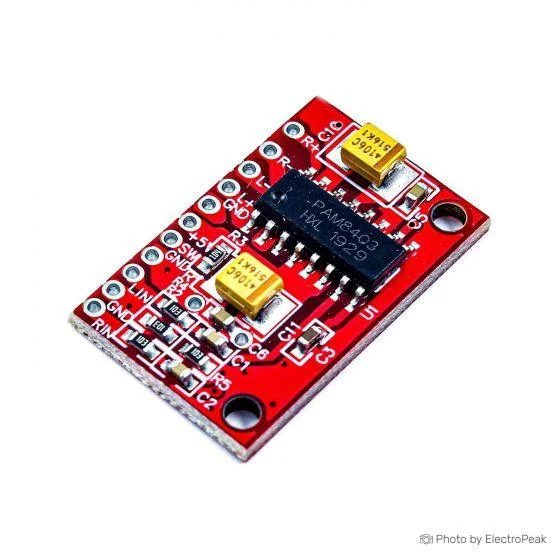
PAM8403 is a stereo class-D power amplifier so it has two amplifier channels for left and right speakers, but here I am going to use only the Left channel. Connect the pins of the PAM8403 according to the given wiring scheme.
Vcc ——-> To the positive supply rail of the lower breadboard
GND ——> To the negative supply rail of the lower brad board
L-OUT+ —–> To the positive pin of the Loudspeaker
L-OUT- —–> To the negative pin of the loudspeaker
L-IN —–> To the viper pin or middle pin of 10K potentiometer
Step 4: Connecting Potentiometer
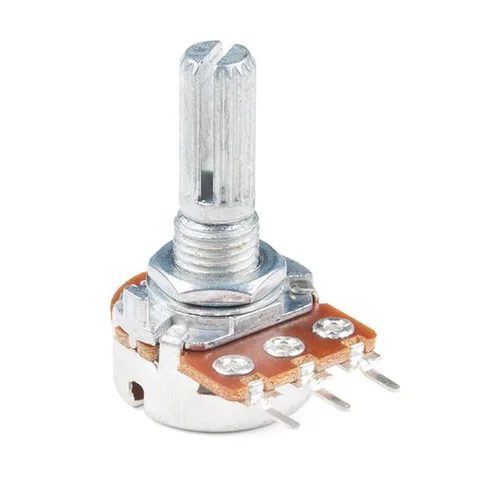
Insert the 10K potentiometer to the lower breadboard as given in the picture. Connect the pins of 10K potentiometer according to the given wiring scheme:
Left-pin ——-> To the negative supply rail of lower bread board
Right-Pin ——-> To 0.1UP capacitor
Middle-Pin ——-> To the L-IN pin of the PAM8403 Board
Insert two pushbuttons in the middle of the lower bread board and connect their pins according the given wiring scheme.
Left-Pin —–> GPIO-10
Right-Pin —–> To negative supply rail of lower bread board
Left-Pin ——> GPIO-10
Right-Pin ——-> To the negative supply rail of lower bread board
Here all the wiring of the hardware is done. It is also necessary to recheck all the connections twice to check out all the connections are right ad tight.
Step 6: Rechecking All Wiring Connections
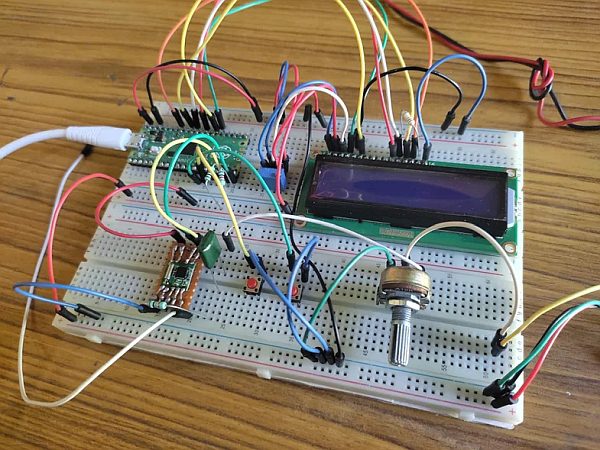
After rechecking all the wiring connections, connect the Raspberry pi pico to Laptop or computer and open the Thonny on the system. Now go to tools and then choose options and a new box will open as shown in the image. Here in the first section, you have to choose the micropython (Raspberry pi pico) and in the second option we have to choose the COM port on which our pi pico board is connected to and clink on OK. Now your pico will connect to Thonny.
Note – If you have any doubt about it then check my “Raspberry pi pico” Instructables to get rid of any connectivity problem.
Step 7: Programming (python Modules and Main File)
First open a new file in Thonny and paste the following python code and save the file in lib folder in Raspberry pi pico with the name ‘gpio_lcd.py’.
"""Implements a HD44780 character LCD connected via ESP32 GPIO pins.""" from lcd_api import LcdApi from machine import Pin from utime import sleep_ms, sleep_us class GpioLcd(LcdApi): """Implements a HD44780 character LCD connected via ESP32 GPIO pins.""" def __init__(self, rs_pin, enable_pin, d0_pin=None, d1_pin=None, d2_pin=None, d3_pin=None, d4_pin=None, d5_pin=None, d6_pin=None, d7_pin=None, rw_pin=None, backlight_pin=None, num_lines=2, num_columns=16): """Constructs the GpioLcd object. All of the arguments must be machine.Pin objects which describe which pin the given line from the LCD is connected to. When used in 4-bit mode, only D4, D5, D6, and D7 are physically connected to the LCD panel. This function allows you call it like GpioLcd(rs, enable, D4, D5, D6, D7) and it will interpret that as if you had actually called: GpioLcd(rs, enable, d4=D4, d5=D5, d6=D6, d7=D7) The enable 8-bit mode, you need pass d0 through d7. The rw pin isn't used by this library, but if you specify it, then it will be set low. """ self.rs_pin = rs_pin self.enable_pin = enable_pin self.rw_pin = rw_pin self.backlight_pin = backlight_pin self._4bit = True if d4_pin and d5_pin and d6_pin and d7_pin: self.d0_pin = d0_pin self.d1_pin = d1_pin self.d2_pin = d2_pin self.d3_pin = d3_pin self.d4_pin = d4_pin self.d5_pin = d5_pin self.d6_pin = d6_pin self.d7_pin = d7_pin if self.d0_pin and self.d1_pin and self.d2_pin and self.d3_pin: self._4bit = False else: # This is really 4-bit mode, and the 4 data pins were just # passed as the first 4 arguments, so we switch things around. self.d0_pin = None self.d1_pin = None self.d2_pin = None self.d3_pin = None self.d4_pin = d0_pin self.d5_pin = d1_pin self.d6_pin = d2_pin self.d7_pin = d3_pin self.rs_pin.init(Pin.OUT) self.rs_pin.value(0) if self.rw_pin: self.rw_pin.init(Pin.OUT) self.rw_pin.value(0) self.enable_pin.init(Pin.OUT) self.enable_pin.value(0) self.d4_pin.init(Pin.OUT) self.d5_pin.init(Pin.OUT) self.d6_pin.init(Pin.OUT) self.d7_pin.init(Pin.OUT) self.d4_pin.value(0) self.d5_pin.value(0) self.d6_pin.value(0) self.d7_pin.value(0) if not self._4bit: self.d0_pin.init(Pin.OUT) self.d1_pin.init(Pin.OUT) self.d2_pin.init(Pin.OUT) self.d3_pin.init(Pin.OUT) self.d0_pin.value(0) self.d1_pin.value(0) self.d2_pin.value(0) self.d3_pin.value(0) if self.backlight_pin is not None: self.backlight_pin.init(Pin.OUT) self.backlight_pin.value(0) # See about splitting this into begin sleep_ms(20) # Allow LCD time to powerup # Send reset 3 times self.hal_write_init_nibble(self.LCD_FUNCTION_RESET) sleep_ms(5) # need to delay at least 4.1 msec self.hal_write_init_nibble(self.LCD_FUNCTION_RESET) sleep_ms(1) self.hal_write_init_nibble(self.LCD_FUNCTION_RESET) sleep_ms(1) cmd = self.LCD_FUNCTION if not self._4bit: cmd |= self.LCD_FUNCTION_8BIT self.hal_write_init_nibble(cmd) sleep_ms(1) LcdApi.__init__(self, num_lines, num_columns) if num_lines > 1: cmd |= self.LCD_FUNCTION_2LINES self.hal_write_command(cmd) def hal_pulse_enable(self): """Pulse the enable line high, and then low again.""" self.enable_pin.value(0) sleep_us(1) self.enable_pin.value(1) sleep_us(1) # Enable pulse needs to be > 450 nsec self.enable_pin.value(0) sleep_us(100) # Commands need > 37us to settle def hal_write_init_nibble(self, nibble): """Writes an initialization nibble to the LCD. This particular function is only used during initialization. """ self.hal_write_4bits(nibble >> 4) def hal_backlight_on(self): """Allows the hal layer to turn the backlight on.""" if self.backlight_pin: self.backlight_pin.value(1) def hal_backlight_off(self): """Allows the hal layer to turn the backlight off.""" if self.backlight_pin: self.backlight_pin.value(0) def hal_write_command(self, cmd): """Writes a command to the LCD. Data is latched on the falling edge of E. """ self.rs_pin.value(0) self.hal_write_8bits(cmd) if cmd <= 3: # The home and clear commands require a worst # case delay of 4.1 msec sleep_ms(5) def hal_write_data(self, data): """Write data to the LCD.""" self.rs_pin.value(1) self.hal_write_8bits(data) def hal_write_8bits(self, value): """Writes 8 bits of data to the LCD.""" if self.rw_pin: self.rw_pin.value(0) if self._4bit: self.hal_write_4bits(value >> 4) self.hal_write_4bits(value) else: self.d3_pin.value(value & 0x08) self.d2_pin.value(value & 0x04) self.d1_pin.value(value & 0x02) self.d0_pin.value(value & 0x01) self.hal_write_4bits(value >> 4) def hal_write_4bits(self, nibble): """Writes 4 bits of data to the LCD.""" self.d7_pin.value(nibble & 0x08) self.d6_pin.value(nibble & 0x04) self.d5_pin.value(nibble & 0x02) self.d4_pin.value(nibble & 0x01) self.hal_pulse_enable()
open a new file in Thonny again and copy the following python code and save it in the lib folder in raspberry pi pico with file name’ lcd_api.py’.
"""Provides an API for talking to HD44780 compatible character LCDs.""" import time class LcdApi: """Implements the API for talking with HD44780 compatible character LCDs. This class only knows what commands to send to the LCD, and not how to get them to the LCD. It is expected that a derived class will implement the hal_xxx functions. """ # The following constant names were lifted from the avrlib lcd.h # header file, however, I changed the definitions from bit numbers # to bit masks. # # HD44780 LCD controller command set LCD_CLR = 0x01 # DB0: clear display LCD_HOME = 0x02 # DB1: return to home position LCD_ENTRY_MODE = 0x04 # DB2: set entry mode LCD_ENTRY_INC = 0x02 # --DB1: increment LCD_ENTRY_SHIFT = 0x01 # --DB0: shift LCD_ON_CTRL = 0x08 # DB3: turn lcd/cursor on LCD_ON_DISPLAY = 0x04 # --DB2: turn display on LCD_ON_CURSOR = 0x02 # --DB1: turn cursor on LCD_ON_BLINK = 0x01 # --DB0: blinking cursor LCD_MOVE = 0x10 # DB4: move cursor/display LCD_MOVE_DISP = 0x08 # --DB3: move display (0-> move cursor) LCD_MOVE_RIGHT = 0x04 # --DB2: move right (0-> left) LCD_FUNCTION = 0x20 # DB5: function set LCD_FUNCTION_8BIT = 0x10 # --DB4: set 8BIT mode (0->4BIT mode) LCD_FUNCTION_2LINES = 0x08 # --DB3: two lines (0->one line) LCD_FUNCTION_10DOTS = 0x04 # --DB2: 5x10 font (0->5x7 font) LCD_FUNCTION_RESET = 0x30 # See "Initializing by Instruction" section LCD_CGRAM = 0x40 # DB6: set CG RAM address LCD_DDRAM = 0x80 # DB7: set DD RAM address LCD_RS_CMD = 0 LCD_RS_DATA = 1 LCD_RW_WRITE = 0 LCD_RW_READ = 1 def __init__(self, num_lines, num_columns): self.num_lines = num_lines if self.num_lines > 4: self.num_lines = 4 self.num_columns = num_columns if self.num_columns > 40: self.num_columns = 40 self.cursor_x = 0 self.cursor_y = 0 self.implied_newline = False self.backlight = True self.display_off() self.backlight_on() self.clear() self.hal_write_command(self.LCD_ENTRY_MODE | self.LCD_ENTRY_INC) self.hide_cursor() self.display_on() def clear(self): """Clears the LCD display and moves the cursor to the top left corner. """ self.hal_write_command(self.LCD_CLR) self.hal_write_command(self.LCD_HOME) self.cursor_x = 0 self.cursor_y = 0 def show_cursor(self): """Causes the cursor to be made visible.""" self.hal_write_command(self.LCD_ON_CTRL | self.LCD_ON_DISPLAY | self.LCD_ON_CURSOR) def hide_cursor(self): """Causes the cursor to be hidden.""" self.hal_write_command(self.LCD_ON_CTRL | self.LCD_ON_DISPLAY) def blink_cursor_on(self): """Turns on the cursor, and makes it blink.""" self.hal_write_command(self.LCD_ON_CTRL | self.LCD_ON_DISPLAY | self.LCD_ON_CURSOR | self.LCD_ON_BLINK) def blink_cursor_off(self): """Turns on the cursor, and makes it no blink (i.e. be solid).""" self.hal_write_command(self.LCD_ON_CTRL | self.LCD_ON_DISPLAY | self.LCD_ON_CURSOR) def display_on(self): """Turns on (i.e. unblanks) the LCD.""" self.hal_write_command(self.LCD_ON_CTRL | self.LCD_ON_DISPLAY) def display_off(self): """Turns off (i.e. blanks) the LCD.""" self.hal_write_command(self.LCD_ON_CTRL) def backlight_on(self): """Turns the backlight on. This isn't really an LCD command, but some modules have backlight controls, so this allows the hal to pass through the command. """ self.backlight = True self.hal_backlight_on() def backlight_off(self): """Turns the backlight off. This isn't really an LCD command, but some modules have backlight controls, so this allows the hal to pass through the command. """ self.backlight = False self.hal_backlight_off() def move_to(self, cursor_x, cursor_y): """Moves the cursor position to the indicated position. The cursor position is zero based (i.e. cursor_x == 0 indicates first column). """ self.cursor_x = cursor_x self.cursor_y = cursor_y addr = cursor_x & 0x3f if cursor_y & 1: addr += 0x40 # Lines 1 & 3 add 0x40 if cursor_y & 2: # Lines 2 & 3 add number of columns addr += self.num_columns self.hal_write_command(self.LCD_DDRAM | addr) def putchar(self, char): """Writes the indicated character to the LCD at the current cursor position, and advances the cursor by one position. """ if char == '\n': if self.implied_newline: # self.implied_newline means we advanced due to a wraparound, # so if we get a newline right after that we ignore it. pass else: self.cursor_x = self.num_columns else: self.hal_write_data(ord(char)) self.cursor_x += 1 if self.cursor_x >= self.num_columns: self.cursor_x = 0 self.cursor_y += 1 self.implied_newline = (char != '\n') if self.cursor_y >= self.num_lines: self.cursor_y = 0 self.move_to(self.cursor_x, self.cursor_y) def putstr(self, string): """Write the indicated string to the LCD at the current cursor position and advances the cursor position appropriately. """ for char in string: self.putchar(char) def custom_char(self, location, charmap): """Write a character to one of the 8 CGRAM locations, available as chr(0) through chr(7). """ location &= 0x7 self.hal_write_command(self.LCD_CGRAM | (location << 3)) self.hal_sleep_us(40) for i in range(8): self.hal_write_data(charmap[i]) self.hal_sleep_us(40) self.move_to(self.cursor_x, self.cursor_y) def hal_backlight_on(self): """Allows the hal layer to turn the backlight on. If desired, a derived HAL class will implement this function. """ pass def hal_backlight_off(self): """Allows the hal layer to turn the backlight off. If desired, a derived HAL class will implement this function. """ pass def hal_write_command(self, cmd): """Write a command to the LCD. It is expected that a derived HAL class will implement this function. """ raise NotImplementedError def hal_write_data(self, data): """Write data to the LCD. It is expected that a derived HAL class will implement this function. """ raise NotImplementedError def hal_sleep_us(self, usecs): """Sleep for some time (given in microseconds).""" time.sleep_us(usecs)
Now again open a new file in Thonny and paste the following code in this file and then save it in the Raspberry pi pico with file name ‘main.py’.
from machine import Pin, I2C
from gpio_lcd import GpioLcd
import time
push1 = Pin(10, Pin.IN, Pin.PULL_UP)
push2 = Pin(11, Pin.IN, Pin.PULL_UP)
frec = 92.7
frec1 = 92
frec2 = 7
std1 = 1
std2 = 1
i2c = I2C(1,scl=Pin(15), sda=Pin(14), freq=400000)
lcd = GpioLcd(rs_pin=Pin(20),
enable_pin=Pin(21),
d4_pin=Pin(22),
d5_pin=Pin(26),
d6_pin=Pin(27),
d7_pin=Pin(28),
num_lines=2, num_columns=16)
lcd.move_to(2,0)
lcd.putstr('--FM Radio--')
time.sleep_ms(10)
def radio_frequency(freq):
freqB = 4 * (freq * 1000000 + 225000) / 32768
buf = bytearray(5)
buf[0] = int(freqB) >> 8
buf[1] = int(freqB) & 0XFF
buf[2] = 0X90
buf[3] = 0X1E
buf[4] = 0X00
i2c.writeto(0x60, buf)
time.sleep_ms(10)
def print_frequency(freq1, freq2):
lcd.move_to(4,1)
str_freq = str(freq1) + "." + str(freq2) + " MHZ "
lcd.putstr(str_freq)
time.sleep_ms(10)
radio_frequency(frec)
print_frequency(frec1,frec2)
while True:
if push1.value() == 0:
time.sleep_ms(10)
if push1.value() == 0:
std1 = 0
time.sleep_ms(10)
if push1.value() == 1 and std1 == 0:
frec2 = frec2 + 1
if frec2 > 9:
frec1 = frec1 + 1
frec2 = 0
if frec1 == 108 and frec2==1:
frec1 = 88
frec2 = 0
frec = frec1 + (frec2/10)
radio_frequency(frec)
print_frequency(frec1,frec2)
std1 = 1
if push2.value() == 0:
time.sleep_ms(10)
if push2.value() == 0:
std2 = 0
time.sleep_ms(10)
if push2.value() == 1 and std2 == 0:
frec2 = frec2 - 1
if frec2 < 0:
frec1 = frec1 - 1
frec2 = 9
if frec1 == 87 and frec2 == 9:
frec1 = 108
frec2 = 0
frec = frec1 + (frec2/10)
radio_frequency(frec)
print_frequency(frec1,frec2)
std2 = 1
now click on run option and radio starts, you can listen your favorite FM radio stations now.
all the above micro python files are also available on my GitHub account visit the link:
https://github.com/ramjipatel041/Raspberrypipico_radio.git


